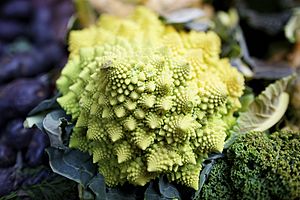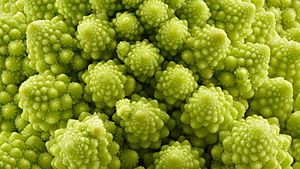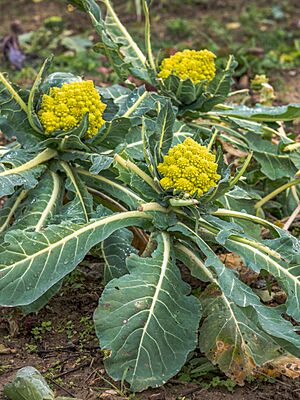Romanesco broccoli facts for kids
Quick facts for kids Romanesco |
|
|---|---|

Romanesco, showing its self-similar form
|
|
| Species | Brassica oleracea |
| Cultivar group | Botrytis cultivar group |
Romanesco broccoli is a cool vegetable that looks a bit like a mix between cauliflower and broccoli. People also call it Roman cauliflower or just Romanesco. It's actually the edible flower bud of a plant called Brassica oleracea.
This unique veggie was first written about in Italy way back in the 1500s. It has a bright, yellowish-green color, which is called chartreuse. What makes Romanesco really special is its amazing shape, which looks like a natural fractal. Compared to regular cauliflower, Romanesco is a bit firmer and has a mild, nutty taste.
What is Romanesco?
Romanesco looks a lot like a cauliflower, but it's a bright chartreuse color. Its most amazing feature is its natural fractal shape. This means it has a pattern that repeats itself over and over, getting smaller each time.
This vegetable is also super healthy! It's packed with important nutrients. Romanesco is a great source of vitamin C and vitamin K. It also gives you lots of dietary fiber, which helps your body digest food. Plus, it has special compounds called carotenoids, which are good for your health.
The Amazing Fractal Shape
The flower bud of Romanesco broccoli has a shape that is called self-similar. Imagine a big part of the Romanesco. Now look closer, and you'll see smaller parts that look just like the big one! This pattern keeps repeating itself on even smaller parts.
Each little bud on the Romanesco is made of even tinier buds. These are all arranged in a special spiral pattern. This repeating, spiraling design is what makes it a natural fractal. The pattern doesn't go on forever, but it repeats many times.
Scientists have studied why Romanesco looks so different from regular cauliflower or broccoli. They found that its unique shape happens because of how its genes work. Instead of growing into normal flowers, the plant's growth points keep repeating the same pattern. This creates the beautiful and complex fractal shape we see.
See also
 In Spanish: Romanesco o romicia para niños
In Spanish: Romanesco o romicia para niños




